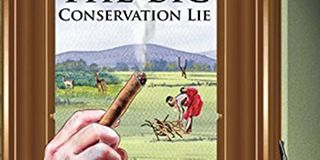BOOK NOOK: The Big Conservation Lie

What you need to know:
- The truth, an unsettling one for that matter, is that the local communities continue to suffer.
- From being relocated from their lands to drier areas without water for their use and for their animals, to being shot at by Kenya Wildlife Service guards on allegations of poaching.
- The local communities such as the Maasai who reside in areas surrounding the parks continue to suffer immeasurable pain and total disrespect.
Author: John Mbaria & Mordecai Ogada
Genre: Nonfiction (Wildlife Conservation)
Year of Publication: 2017
Publisher: Lens&Pens Publishing
Availability: NURIA BOOKSTORE
Price: Sh. 2,299
Recently, there was massive uproar on the internet in protest of an announcement by the Ministry of Tourism that British Supermodel Naomi Campbell, had “…agreed to be Magical Kenya’s International Tourism Ambassador.” Many Kenyans questioned Ms Campbell’s credentials, and even compared her to Kenyan Hollywood actress Lupita Nyong’o. The announcement further noted that the move would “…promote the marketing of Kenya as an ideal tourism and travel destination to the world.” This, in essence, suggests that the premise on which the ambassadorial post was offered to Campbell, was to attract foreign exchange to Kenya through tourism.
However, what most of those who challenged the move seem unaware of is that the culture of “the white saviour complex” and neo-colonial attitudes in the Kenyan wildlife sector have been entrenched for eons now. This is widely detailed in John Mbaria and Mordecai Ogada’s book, The Big Conservation Lie. The authors, who assume extravagant experience and knowledge in the matters of wildlife conservation, take the trouble of candidly exposing the rot and exploitation in the conservation sector, and unearth the underground activities that have gone on unabated since before independence.
Integral to their research is the manner in which the conservation policies are designed, with an aim of excluding the African local communities which have coexisted with the biodiversity, and particularly, the wild animals, for centuries. Ogada, a former worker at Kenya Wildlife Trust, an organisation whose main job is to conserve the animals, says that his experience at the organisation made him realise that the aim of the conservationists was only to manipulate the authorities and the locals, take control of the animal parks and make top dollar from it.
The assumption that is usually held, and which many people like to console themselves with, is that the local communities benefit from the existence of the luxurious lodges and animal parks that are owned and managed by the white conservationists and business people. The truth, an unsettling one for that matter, is that the local communities continue to suffer. From being relocated from their lands to drier areas without water for their use and for their animals, to being shot at by Kenya Wildlife Service guards on allegations of poaching. The local communities such as the Maasai who reside in areas surrounding the parks continue to suffer immeasurable pain and total disrespect.
The well-researched and lacking-in-euphemisms text puts the government at the centre of the problems bedeviling the conservation sector. From their practical observations, Mbaria and Ogada state that corruption and racism continue to thrive in the conservation sector. Unfortunate as it may sound, the person with a European accent, and deep pockets calls the shots. Basically, according to the book, the wildlife conservation sector is still a colonial enterprise, only involving the locals in legitimising its existence and operations.
The paragraph I liked best is: “The wildlife conservation narrative in Kenya, as well as much of Africa, is thoroughly intertwined with colonialism, virulent racism, deliberate exclusion of the natives, veiled bribery, unsurpassed deceit, a conservation cult subscribed to by huge numbers of people in the West, and severe exploitation of the same wilderness conservationists have constantly claimed they are out to protect.”
Clearly, you will have to read the book to get angry enough by the bare truths that for long have been hidden from the ordinary man. The realisation that our native brothers and sisters in the communities living near parks continue to suffer, and their welfare undermined, will trigger you to relook the ordinary tales, and maybe demand for change.




